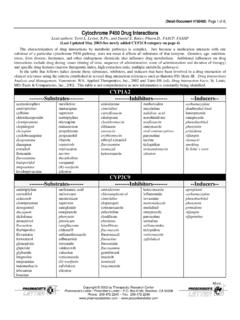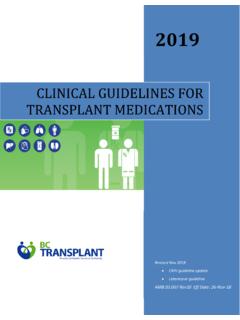Transcription of Pharmacokinetics and pharmacogenomics of tacrolimus: a …
1 CHAPTER 2 Pharmacokinetics and pharmacogenomics of tacrolimus : a review Submitted in an adapted form 14 Chapter 2 1 Introduction tacrolimus (FK506) is a 23-membered macrolide lactone (C44H69NO12; for molecular structure see Figure ) which is isolated from the fermentation broth of Streptomyces tsukubaesis1,2. Additionally, tacrolimus like cyclosporin is an immunosuppressive agent belonging to the calcineurin inhibitor group that has emerged as a valuable therapeutic alternative to cyclosporine following solid organ transplantation3. It is highly effective at preventing rejection in heart4-7, small bowel8,9, pancreas10-14, bone marrow10-14, lung15-19, liver20-24, and kidney25-28 recipients and for the therapy of autoimmune diseases29,30. Figure Structure of tacrolimus . Although there are structural differences, cyclosporin and tacrolimus share a similar cellular mechanism of action, though tacrolimus , is 10 to 100 times more potent at the molecular level31.
2 After entry into the cell, both agents bind to their respective cytosolic immunophilins: cyclosporine to cyclophilin and tacrolimus to the FK506-binding proteins FKBP-12 and FKBP-52, a component of the glucocorticoid receptor complex. Immunophilins are a family of highly conserved proteins that likely participate in protein folding. The drug-immunophilin complex binds to and inhibits the activity of the enzyme calcineurin, a calcium/calmodulin-dependent protein phosphatase that is expressed in all mammalian tissues. As a result, the complex interrupts the calcium-dependent signal transduction pathway in T-cells. Inhibition of calcineurin by cyclosporin or tacrolimus leads to interference with translocation to the nucleus of various nuclear factors involved in the transcription of cytokine genes, such as the cytosolic subunit of the nuclear factor of activated T-cells (NF-ATc).
3 It also antagonizes the interaction of the transcription factor, cyclic adenosine monophosphatase (cAMP)-response element binding protein (CREB), with its putative deoxyribonucleic acid (DNA) binding site, which in turn inhibits Pharmacokinetics and pharmacogenomics of tacrolimus : a review 15 cAMP-directed transcriptional events. As a result of calcineurin inhibition, the transcription of early T-cell activation genes is suppressed, affecting the production of interleukin-2 (IL-2) and many other cytokines, such as interleukin-3 (IL-3), interferon- (INF- ), and tumor necrosis factor- (TNF- ). Figure illustrates a simplified model of the intracellular mode of action of tacrolimus and cyclosporine. Figure Intracellular mode of action of tacrolimus and cyclosporine. Adapted from LC Paul.
4 Mechanistic differences of cornerstone immunosuppressants. ISBN 1-898729-15-8. 2 Absorption, distribution, metabolisation and elimination Absorption tacrolimus , orally administrated, has a large variability in the rate of absorption and absolute bioavailability which implies that the mean bioavailability is approximately 25% but can range from 5% to 93% 32,33. In general oral doses of tacrolimus should be 3 to 4 times higher than intravenous doses to achieve comparable drug exposure after oral and intravenous administration. A reduced bioavailability has been reported in patients awaiting renal transplantation34, in small bowel recipients with open stomas35, in African American and non-Caucasian individuals36-40, in diabetic patients41,42, and following administration of food with a moderate fat content43-45.
5 However, the bioavailability is 16 Chapter 2 similar for paediatric and adult transplant patients42. In most patients tacrolimus is absorbed rapidly with peak plasma/blood concentrations obtained in hour32 however a lag time of 0 to 2 hours has also been reported in some liver transplant recipients37 or an extended lag time or secondary peaks34,46,47. The shape of the plasma concentration-time profile in some patients (sharp peaks), and higher dose-normalised maximum blood concentration at lower doses is seen in some patients who received different doses, are suggestive of the involvement of a zero order/saturable process in the absorption of tacrolimus38. The poor aqueous solubility of tacrolimus and alterations in gut motility in transplant patients may be partially responsible for poor and erratic drug uptake.
6 Presystemic metabolism of tacrolimus by gastrointestinal cytochrome P450 (CYP) 3A iso-enzymes and removal by P-glycoprotein transport is extensive48-50. P-glycoprotein lowers the intracellular concentration of tacrolimus by pumping absorbed drug back out into the intestinal lumen. P-glycoprotein may also regulate access of tacrolimus to CYP3A enzymes and prevents these enzymes from being overwhelmed by high drug concentrations in the intestine51,52. As tacrolimus is repeatedly transported out of the intestinal mucosa cells and then passively reabsorbed, this continous repeated exposure should lead to more efficient metabolism52,53. P-glycoprotein belongs to a family of adenosine triphosphate-binding cassette transporters with considerable overlap in substrate specificity. Bile is not essential for tacrolimus absorption54-56.
7 Simultaneous administration of enteral feeds does not appear to interfere with tacrolimus bioavailability. Contrasting studies appeared regarding the role of ABCB1 polymorphisms in the tacrolimus metabolisation process. A number of studies57-65 found a significant association between the ABCB1 polymorphism C3435T or the ABCB1 haplotype consisting of the polymorphisms C1236T, G2677T/A and C3435T and tacrolimus C0 concentrations or pharmacokinetic parameters, while other studies66-76 found no significant correlation between these parameters. A large diversity of transplant recipient populations were used to examine this ABCB1 genotype tacrolimus blood concentration correlation which may explain the difference in the results observed. Especially, when the role of these ABCB1 polymorphisms is minor compared to the CYP3A polymorphisms.
8 Distribution Transplant recipients have significantly higher blood tacrolimus concentrations (mean 15 times; range 4 to 114 times) than the corresponding plasma concentrations due to the extensive binding of tacrolimus to the red blood cells46,54,77-81. Venkataramanan et reported that the maximum amount of tacrolimus bound to red blood cells (Bmax) is 418 258 g/l with an apparent dissociation constant (KD) of g/l in transplant patients while Bmax is 1127 g/l and KD of g/l in healthy volunteers. The diffusion of tacrolimus from erythocytes is slow in comparison with the transit time of blood through an organ, but tacrolimus is readily released from the erythrocytes82-84, and the binding of tacrolimus to erythrocytes may in part protect it from hepatic metabolism85. An Pharmacokinetics and pharmacogenomics of tacrolimus : a review 17 intracellular protein in erythrocytes, with a molecular weight range (14 to 15 kDa) corresponding to FKBP82, or a molecular weight of 11 to 12 kDa86 appears to be primarily responsible for binding tacrolimus .
9 tacrolimus does not bind to haemoglobin. When the tacrolimus concentration in whole blood increases, the uptake of tacrolimus by erythrocytes is saturated, resulting in a lower blood versus plasma ratio81,82,84,86. Approximately 99% of tacrolimus in plasma is bound, with uptake not saturable at physiological drug concentrations87-89. Additionally, tacrolimus is principally associated with 1-acid glycoprotein, lipoproteins, globulins and albumin. Partitioning of tacrolimus between erythrocytes and plasma ex vivo is dependent on the haematocrit, tacrolimus concentration, temperature of the sample and plasma protein concentration87,90-92. tacrolimus passes through the placenta and into the breast milk78,93,94. In one study94, 21 female liver transplant recipients treated with tacrolimus before and throughout gestation, the mean tacrolimus concentrations ( g/l) on the day of delivery were in the placenta versus , and in the maternal, cord and child plasma, and in the first breast milk specimens.
10 In paediatric liver recipients, a volume of distribution up to times higher than in adult recipients has been reported95. Possible reasons for this include increased membrane permeability of red blood cells and reduced amounts and affinity of plasma binding proteins in infants, enhancing drug entry into some compartments96. Metabolism tacrolimus undergoes O-demethylation, hydroxylation and/or oxidative metabolic reactions, predominantly by CYP3A4 and CYP3A5 in the liver and intestinal wall, with < of the parent drug appearing unchanged in the urine or faeces88,90,93,97-108. Several metabolites are the product of a two-step reaction: oxidation by cytochrome P450 3A enzymes destabilising the macrolide ring and followed by its rearrangement92,102,105,109.






